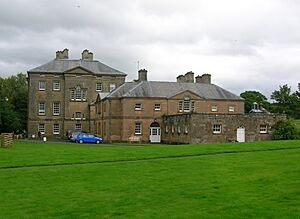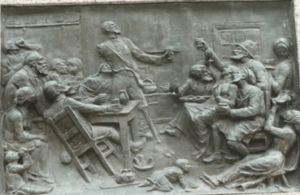James Armour (master mason) facts for kids
Quick facts for kids
James Armour
|
|
|---|---|
| Born | 15 January 1731 |
| Died | 20 September 1798 (aged 68) Mauchline, Scotland
|
| Occupation | Master mason |
| Spouse(s) | Mary Smith |
| Children | 11, including Jean and Adam |
James Armour (born 15 January 1731 – died 20 September 1798) was a skilled master mason. He was the father of Jean Armour and, because of that, the father-in-law of the famous Scottish poet Robert Burns. Records show he was baptized on 24 January 1731. His birth on the original church record is listed as 15 January 1731.
Contents
Life and Family
James Armour married Mary Smith on 7 December 1761 in Mauchline. Mary was the daughter of another stonemason, Adam Smith. James passed away on 30 September 1798 and was buried in the family plot in Mauchline churchyard. His wife, Mary, died in 1805 and was buried next to him.
Who was in James Armour's family?
James and Mary had eleven children together. Their children were John, Jean, James, Robert, Adam, Helen, Mary, Robert (2nd), Mary (2nd), Janet, and Robert (3rd). Sadly, three of their children died when they were young. Their eldest son, Dr. John Armour, was born in Mauchline in 1762. He became a doctor and lived in Kincardine-on-Forth until his death in 1834.
The Armour family lived in a single-story house in Cowgate, Mauchline. It was very close to the Whitefoord Arms Inn. Jean's bedroom window even looked out onto a window of the inn. This allowed Robert Burns to talk to her from the pub! The Whitefoord Inn was a place Burns often visited.
What was James Armour's job and standing in the community?
James Armour was a master mason and a contractor. This means he was a very skilled builder who took on construction projects. Even though Robert Burns sometimes called him an architect, James was more of a builder. He worked on Dumfries House near Cumnock. People also believe he helped build Howford Bridge on the River Ayr and Greenan Bridge on the River Doon. He also worked on Skeldon House in Dalrymple and several other bridges in Ayrshire. Both James's family and his wife's family had been stone-masons for many generations. William Burnes, who was Robert Burns's cousin, even learned his trade by working with James Armour.
James was very traditional and strict in his religious beliefs. He rented one of the most expensive seats in Mauchline church. Robert Burns-Begg, who was Burns's great-nephew, said that James lived a very proper life. However, he also said that James's wife, Mary, was "somewhat gay and frivolous."
A person named William 'Willie' Patrick, who knew a lot of stories about Robert Burns, described James Armour as "only a bit mason body." He also said that James "hated" Robert Burns. He would have preferred to see "the Deil himsel" (the Devil himself) come to his house to court his daughter than Robert Burns!
James Armour and Robert Burns
James Armour did not approve of Robert Burns dating his daughter, Jean. He knew that Burns had different religious views and was not very wealthy. In March 1786, when James found out Jean was expecting a baby, he was very upset. Jean's parents convinced her to go to Paisley to stay with relatives.
Robert Burns had written a paper that made his marriage to Jean official. However, James Armour had this paper damaged. The names of Robert and Jean were cut out. Burns was very hurt by this. James Armour then made Jean sign a complaint against Robert. This led to a warrant being issued to stop Burns from leaving her. Burns had to flee to Old Rome Forest to hide.
On 3 September 1786, Jean and Robert had twins, a boy and a girl. They were named Robert and Jean. Robert Burns was told about the birth by Adam Armour. That Sunday, Burns visited the Armour's house with gifts for Jean and the babies.
Later, Jean became pregnant again. Because of her father's anger, she had to leave the Armour home. She was taken in by friends at Tarbolton Mill. Sadly, this second set of twins did not live long.
When Robert Burns was very ill near the end of his life, he wrote two letters to James Armour. He asked James to send Mary Armour to Dumfries to help care for Jean, who was pregnant again. In his last letter on 10 July 1796, Burns signed it "Your most affectionate son. R. Burns."
After Robert Burns's uncle, Robert Burnes, died, Robert Burns helped his cousin William become a mason. William then worked with James Armour, who was Burns's father-in-law.
The Inveraray Marble Punch Bowl
One special item connected to James Armour and Robert Burns is a punch bowl. James Armour gave this bowl as a wedding gift to his daughter Jean and Robert Burns in 1788. As a stone-mason, James had carved the bowl himself from dark green Inveraray marble.
After living in their various homes, Jean gave the bowl to Robert's good friend, Alexander Cunningham, in 1801. Alexander had a silver base and rim added to the bowl. On the rim, words from Burns's poem "The Epistle to J. Lapraik" were engraved: "Ye whom social pleasure charms .. Come to my Bowl! Come to my arms, My FRIENDS, my BROTHERS!"
The original punch bowl is now in the British Museum in London. A copy of it can be seen at the Robert Burns Birthplace Museum in Alloway.
See also
- Adam Armour
- Jean Armour
- Robert Burnes
- William Burnes







